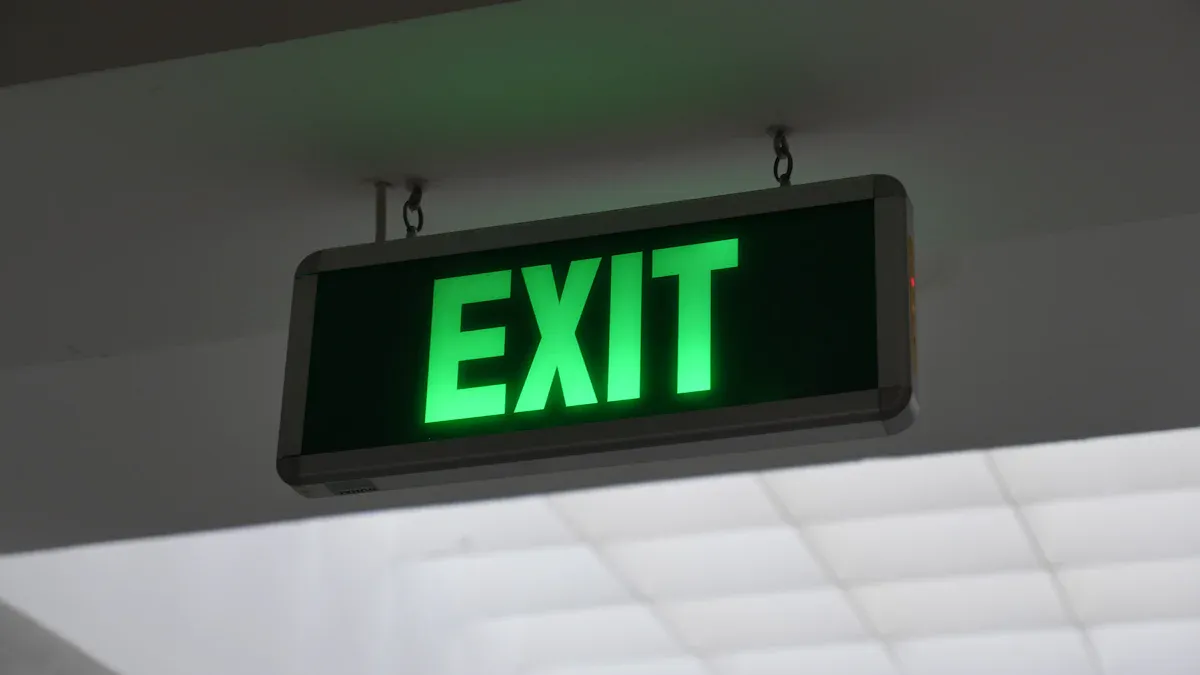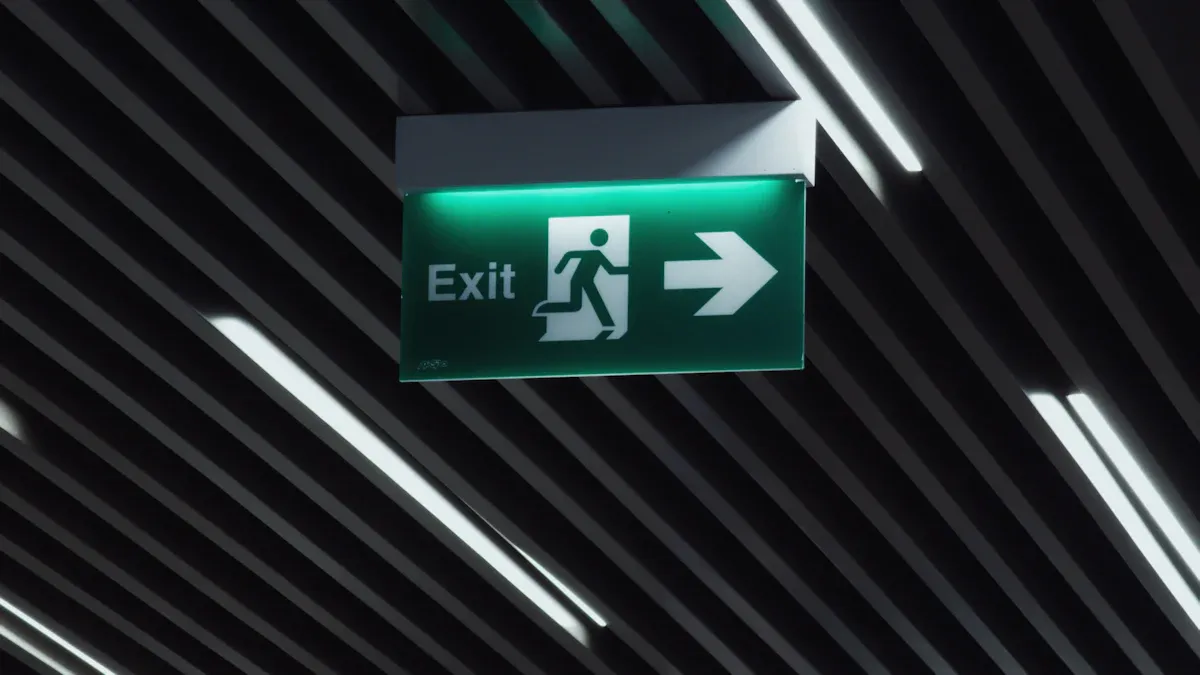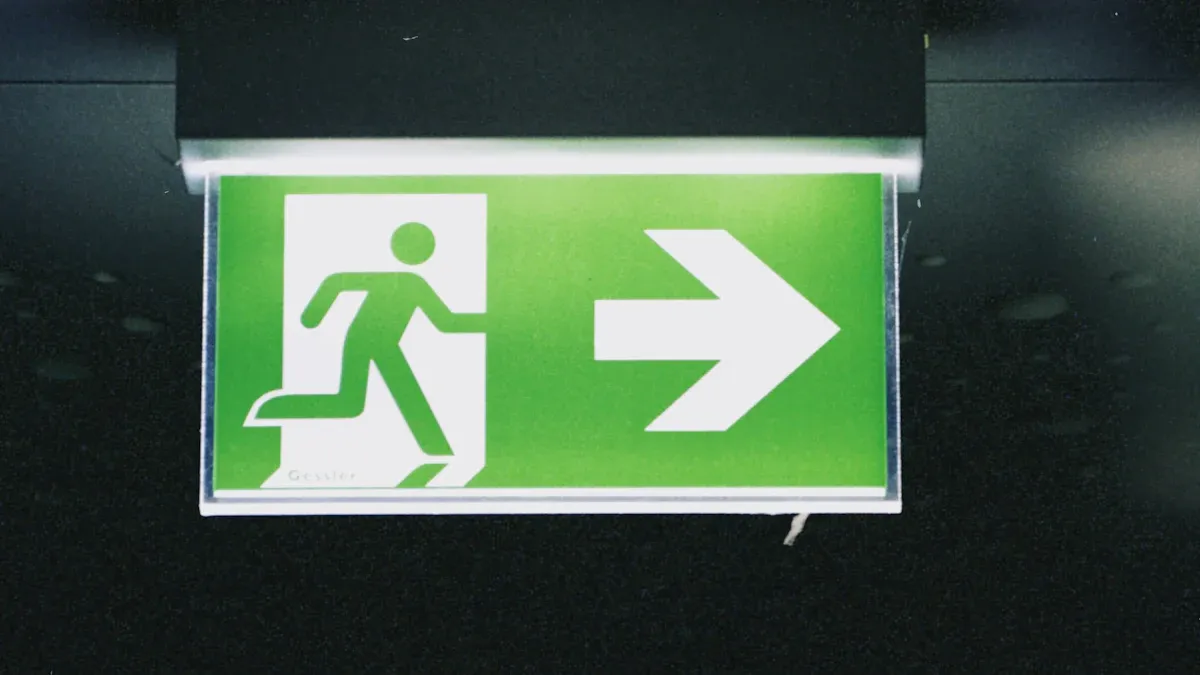Emergency Light: Reliable Exit Emergency Signs for Professional Use

A reliable emergency light or emergency exit signs must provide clear visibility and robust performance in every emergency situation. In professional environments, escape routes rely heavily on effective emergency lighting and strategically positioned emergency exit signs. It is important to distinguish between emergency lighting and emergency exit signs: emergency lighting illuminates the pathways, while emergency exit signs direct occupants towards the escape routes. Recent trends indicate a growing demand for durable and compliant emergency light and emergency exit signs solutions, driven by stringent safety regulations and public building codes.
The global emergency exit sign market reached USD 950 million in 2023 and is projected to grow to USD 1,500 million by 2032, propelled by stricter enforcement of escape and safety standards.
LED technology and self-luminous emergency exit signs provide consistent illumination, ensuring safe public evacuation during power failures or hazardous conditions.
Key Takeaways
Emergency lighting and exit signs are vital for safe evacuation and must remain visible and reliable during power failures or emergencies.
LED technology offers bright, instant illumination with long lifespan and low maintenance, making it the preferred choice for professional emergency lighting.
Strict legal regulations require proper installation, regular testing, and maintenance of emergency lighting to ensure safety and compliance.
Battery backup systems, especially lithium-ion, provide essential power during outages and must be regularly tested to guarantee performance.
Professional installation and routine inspections help maintain emergency lighting effectiveness, reduce risks, and support quick, safe escapes.
Importance of Emergency Lighting
Workplace Safety
Emergency lighting plays a vital role in workplace safety. It ensures that escape routes remain visible and accessible during power failures or emergencies. Proper emergency lighting design highlights hazards and obstacles, reducing the risk of accidents. Open area emergency lighting and escape lighting guide occupants towards exits, preventing panic and confusion.
Emergency lighting illuminates exit routes and key areas, supporting safe and efficient evacuation.
It minimises risks, prevents panic, and enables orderly escape.
Well-lit environments assist first responders in faster rescue operations, improving emergency response.
Open area emergency lighting and escape lighting provide psychological comfort to both occupants and building managers.
Research from the Light and Health Research Centre shows that steady illumination and appropriate light intensity improve visibility and safety for emergency responders at night. Workplace safety standards, such as BS EN 1838:2013, specify minimum illuminance levels for emergency lighting to ensure safe evacuation and continuation of critical operations. Incident statistics link inadequate lighting to increased accidents involving vehicle movements and pedestrian trips. Proper lighting around vehicle routes, junctions, and pedestrian areas reduces collision risks and falls, emphasising the importance of open area emergency lighting and escape lighting in accident prevention.
Legal Compliance
Strict regulations govern emergency lighting in public and professional environments. In the UK and EU, laws such as the Regulatory Reform (Fire Safety) Order 2005 and Building Regulations 2006 require emergency lighting for all escape routes and critical areas. British Standards BS5266 and BS EN50172 set minimum requirements for emergency lighting systems, including open area emergency lighting and escape lighting.
Regulations mandate emergency lighting coverage for exit doors, trip hazards, changes in direction, first aid equipment, fire alarm triggers, fire extinguishers, power supplies, escape routes, emergency escape signs, stairways, and other critical areas.
Landlords must ensure emergency lights operate for three hours as per BS5266.
Automated systems, such as EmeRed, support statutory testing and compliance certification, reducing manual effort and ensuring 100% compliance.
Regular inspections and maintenance of the emergency lighting system prevent failures, reduce legal and financial risks, and enhance overall building safety. Compliance with safety regulations directly improves occupant safety and reduces risks during emergencies. Effective emergency lighting design and adherence to regulations protect both public and private facilities, ensuring safe escape for all occupants.
Key Features
High Visibility
High visibility remains the cornerstone of effective emergency lighting in professional environments. LED exit signs and LED emergency lights deliver instant, bright illumination, ensuring that escape routes and exits remain clearly marked even in dense smoke or darkness. These signs activate without delay, eliminating the risk of dangerous warm-up periods.
LED technology provides uniform illumination, which enhances visibility and hazard identification.
High bay emergency lighting ensures bright, consistent light in large spaces such as warehouses and factories.
LED exit signs maintain up to 100% light output during emergencies, supporting operational safety and productivity.
Visual aids, including red end caps and status indicators, simplify maintenance and improve safety management.
Advanced features such as improved colour rendering help users quickly recognise exits and hazards, supporting a visible direction of escape.
LED exit signs outperform traditional discharge lamps, which often lack instant restrike capability and may fail to meet modern standards for emergency lighting design. The consistent brightness and long lifespan of LED exit signs reduce maintenance costs and ensure reliable performance during emergencies.
Note: High visibility in emergency lighting systems directly supports compliance with safety regulations and standards, reducing risks during evacuation.
Battery Backup
A robust battery backup system is essential for any emergency lighting installation. The battery ensures that LED exit signs and emergency lights continue to function during power outages, maintaining required illumination levels for safe evacuation.
Service Life | Temperature Range | Maintenance Needs | Relative Cost | |
|---|---|---|---|---|
Nickel-Cadmium | 15-20 years | -20°C to 60°C | Monthly testing | Medium |
Sealed Lead-Acid | 3-5 years | 10°C to 30°C | Monthly testing + specific gravity | Low |
Lithium-Ion | 10-12 years | 0°C to 43°C | Minimal | High |
Battery selection affects the emergency lighting system's efficiency, lifespan, and maintenance requirements. Lithium-ion batteries, for example, offer long service life and minimal maintenance, making them ideal for demanding environments. Proper battery sizing, temperature derating, and regular testing ensure compliance with standards such as NFPA 101, which mandates a minimum 90-minute runtime for emergency lighting.
Smart battery systems with diagnostics can predict failures and simplify maintenance, though they may increase initial costs. Centralised battery inverter systems provide full rated output for the entire emergency period but represent a single point of failure. Unit equipment with self-contained batteries, often called "bug-eyes," offer dedicated illumination but require careful placement to balance light output.
A critical feature supporting emergency light selection is solid battery life, which allows lighting systems to operate for extended periods—hours or even days—during outages. This efficiency in energy use ensures that spaces remain safe and comfortable when power is lost, reinforcing the importance of energy-efficient and reliable battery-backed lighting solutions.
Durability
Durability defines the long-term reliability of emergency lighting and exit signage. LED exit signs and LED emergency lights feature robust construction, high efficiency, and low heat generation, which contribute to their extended lifespan.
Lithium-ion batteries in emergency lights typically last over five years before replacement.
LED light sources offer high efficiency and long-lasting performance, reducing the frequency of maintenance.
Monthly 30-second functionality tests and annual 90-minute runtime tests ensure ongoing reliability and early detection of issues.
Products such as Squarebeam Elite and Quattro Triproof Batten are certified for operation at elevated temperatures (up to 50°C), demonstrating suitability for harsh environments.
Case studies from recent years show zero failures in post-installation audits and improved emergency light runtime, supporting claims of robust construction.
Strict quality control and adherence to international standards guarantee that emergency lighting systems withstand demanding conditions. The sturdy design of LED exit signs and emergency lights ensures reliable operation in diverse environments, from data centres to industrial facilities.
Easy Installation
Easy installation is a key consideration for professional emergency lighting and signage. Modern LED exit signs and emergency lights offer flexible mounting options, including wall, ceiling, and recessed installations. These features simplify the process for facility managers and reduce installation time.
LED exit signs are lightweight and compact, allowing for quick and secure mounting.
Universal mounting brackets and snap-fit designs support various installation scenarios.
Clear labelling and wiring diagrams assist installers in achieving compliance with regulations and standards.
Self-luminous tritium exit signs require no external power or wiring, making them suitable for remote or challenging locations.
Tip: Professional installation ensures that emergency lighting systems meet all relevant standards and regulations, supporting both safety and compliance.
The combination of advanced LED technology, reliable battery backup, robust durability, and straightforward installation makes modern emergency lighting and exit signage the preferred choice for professional environments. These features collectively guarantee safe, reliable, and long-lasting emergency lighting suitable for diverse applications, supporting both operational safety and regulatory compliance.
Types of Emergency Light

LED Exit Signs
LED exit signs have become the standard in professional emergency lighting systems. These signs use advanced LED technology to provide bright, uniform illumination, ensuring that exit routes remain visible during any emergency. Facilities choose LED exit signs for their long lifespan, low maintenance, and high energy efficiency. Unlike older incandescent or fluorescent signs, LED exit signs do not require colour filters, which improves both reliability and clarity.
Note: Research shows that LED exit signs must be legible from at least 100 feet under clear conditions, with a recommended luminance of 15 cd/m² for optimal visibility. However, nearly 25% of measured signs fall below this level, especially in smoky conditions, which can reduce their effectiveness during an emergency.
A comparison of performance and energy metrics for LED exit signs:
Performance/Energy Metric | Details/Statistics |
|---|---|
Common LED colours | Red and green |
Energy efficiency reason for LED adoption | Reduced power consumption and long life |
Legibility distance in smoke (at 15 cd/m²) | Approximately 20 feet |
Maintenance challenge | Signs may appear lit but be too dim in smoky conditions |
LED exit signs support compliance with NFPA 101 and UL 924 standards, making them suitable for a wide range of professional environments. Their energy-saving features and robust construction make them a preferred choice for modern emergency signage.
Tritium Exit Signs
Tritium exit signs offer a self-powered solution for emergency lighting. These signs use radioactive tritium gas to produce illumination without external power or wiring. Tritium exit signs operate continuously, providing reliable visibility even during prolonged power failures.
Facilities often select tritium exit signs for remote or challenging locations where wiring is impractical. While they eliminate electricity and maintenance costs, they involve higher purchase and disposal expenses due to the radioactive material. Special handling and disposal procedures are required at the end of their service life.
Tip: Tritium exit signs provide zero energy costs and minimal maintenance, but organisations must factor in regulatory requirements for safe disposal.
Combo Units
Combo units combine LED exit signs with integrated emergency light heads. These fixtures deliver both exit signage and emergency illumination in a single, compact unit. Combo units are popular in corridors and stairwells, where they help meet code-required light levels with fewer installations.
Combo units typically feature two adjustable LED light heads for flexible coverage.
LED components consume less than five watts, supporting energy efficiency.
Swivel-stem luminaires allow precise aiming, improving light distribution during an emergency.
Fewer units may be needed, reducing overall installation and maintenance costs.
Combo units enhance system reliability and simplify compliance with emergency lighting standards. Their design supports both clear exit signage and effective emergency light coverage, making them a practical choice for professional settings.
Choosing Exit Signs

Assessing Needs
Selecting the right emergency exit signs begins with a thorough assessment of the facility. Safety officers must consider the building layout, the number and location of exits, and the occupancy load. The Regulatory Reform (Fire Safety) Order 2005 requires that emergency routes and exits remain clear and lead directly to a place of safety. Evacuation must be possible quickly and safely, so the number, distribution, and size of exits must match the building’s use and occupancy. Emergency doors should open in the direction of escape, and sliding or revolving doors are not suitable for emergency use. Clear signage above each fire exit door ensures visibility, while escape lighting provides adequate illumination if normal lighting fails.
Tip: Place illuminated exit signs at all exit doors, stairwells, and along escape routes to guide occupants efficiently.
Product Evaluation
Facilities must evaluate exit signs based on performance, durability, and suitability for the environment. LED exit signs offer energy efficiency, bright illumination, and long service life, making them ideal for most professional settings. Photoluminescent signs glow in darkness without electricity, while tritium signs provide self-illumination for remote locations. When choosing emergency signage, consider weatherproofing and resistance to vandalism or accidental damage.
A practical evaluation checklist includes:
Confirm the type of exit sign matches the building’s needs (LED exit signs, photoluminescent, or tritium).
Ensure signs are installed at heights between 6 and 12 feet for readability.
Use directional arrows when escape paths are not obvious.
Check that signs are well-lit, unobstructed, and visible from all points.
Factor in upfront cost, energy consumption, and maintenance frequency.
Routine inspections and maintenance, such as replacing burnt-out bulbs and cleaning, keep emergency exit signs functional and compliant.
Ensuring Compliance
Compliance with legal standards is essential for all emergency exit signage. Signs must be visible from any point in the building, even through smoke or obstructions. Install exit signs at a minimum height of 6 feet on walls or ceilings, using red or green colours with letters at least 6 inches high. Directional arrows must point to the nearest exit and remain illuminated at all times.
Compliance Requirement | Details |
|---|---|
Visibility | Signs must be visible from all building points, including through smoke |
Illumination | Reliable, consistent, with backup power supply |
Lettering | At least 6 inches high, sans-serif font, clear contrast |
Placement | Every exit doorway, stairwell, and along escape routes |
Accessibility | Tactile and Braille features at required locations |
Escape lighting must support the visibility of exit signage during power failures. Regular documentation of inspections and maintenance ensures ongoing compliance with both national and local regulations.
Installation and Maintenance
Placement
Correct placement of emergency lighting ensures safe evacuation during an emergency. Facility managers should position emergency lights to illuminate all escape routes, stairwells, and exit doors. Install emergency lighting at changes in direction, near fire equipment, and at every exit point. Place units at heights that maximise visibility and avoid obstructions. Professional installation guarantees compliance with British Standards and reduces the risk of missed coverage. The UK government highlights the need for competent installers, as improper placement can lead to false alarms or ineffective emergency lighting during a crisis.
Tip: Always appoint trained professionals for installation to ensure all emergency lighting meets legal and safety requirements.
Testing
Regular testing forms the backbone of a reliable emergency lighting system. Facility teams must carry out both visual inspections and functional tests to confirm that emergency lighting activates during power failures. Monthly checks help identify damage, obstructions, or battery issues. Annual full-duration tests simulate extended outages, verifying that emergency lighting remains operational for the required 90 minutes.
Inspect batteries for corrosion, leaks, and secure connections.
Activate test buttons to simulate emergencies and check immediate illumination.
Confirm all escape paths remain lit during testing.
Reset systems and ensure batteries recharge after each test.
Follow manufacturer guidelines for emergency lighting testing intervals.
A structured approach to testing reduces the risk of system failure and supports compliance with fire safety regulations.
Maintenance Schedule
A robust maintenance schedule keeps emergency lighting effective and compliant. Facility managers should track inspection and maintenance frequency, following manufacturer recommendations. Detailed logs must record battery voltage, light performance, and test durations. Each entry should include inspection dates, technician names, and any repairs or issues found. Setting reminders for upcoming inspections and battery replacements helps maintain system reliability.
Maintain thorough records of all emergency lighting testing and maintenance.
Ensure technicians sign off on each test and store records securely for audits.
Ongoing training for maintenance staff builds competence and trust, as emphasised by the Fire Industry Association.
Professional support for installation and maintenance ensures that emergency lighting systems remain up to date with evolving standards, reducing risks and improving safety outcomes.
Reliable emergency lighting and exit signs protect people in every emergency. These systems support safety and compliance in public and professional spaces. Facility managers must assess emergency lighting regularly, install equipment correctly, and maintain all signs. Investing in quality solutions reduces risk and improves emergency response. Facility teams should review current emergency lighting and exit signs to ensure readiness for any emergency.
FAQ
What is the minimum duration emergency lights must operate during a power failure?
British Standards require emergency lights to function for at least 3 hours during a power outage. This ensures safe evacuation and compliance with legal regulations.
How often should facility managers test emergency lighting systems?
Facility managers should conduct monthly functional tests and annual full-duration tests. Regular checks help identify faults early and maintain compliance with safety standards.
Can LED exit signs be used outdoors?
Manufacturers design specific LED exit signs for outdoor use. These models feature weatherproof casings and robust construction to withstand harsh conditions.
Do tritium exit signs require maintenance?
Tritium exit signs need minimal maintenance. However, facility managers must monitor expiry dates and arrange safe disposal according to regulatory guidelines.
What records should be kept for emergency lighting maintenance?
Facility managers should keep detailed logs of all inspections, tests, repairs, and battery replacements. Accurate records support compliance and simplify audits.
